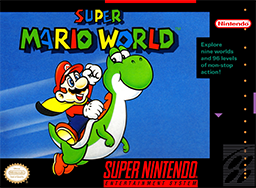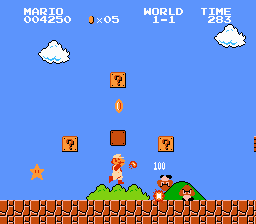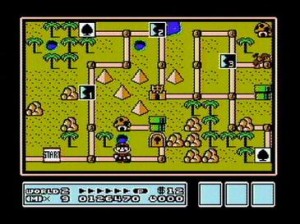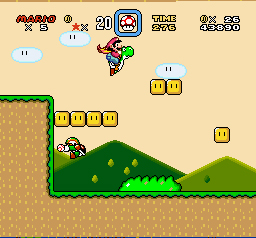As discussed in this week’s Bup Talk on the podcast, which one should listen to if they have not already, I really have not been playing anything of note the past few weeks. I played a couple hours of Xenoblade Chronicles for the 3DS, but not nearly enough that I feel confident in writing at length about the game. I also played a bit of the remaster of Resident Evil on the PS4, but again not enough to write about. However, one game has caught my attention multiple times over the past week. I will start one game and stop it just to start playing this game again. That game, as my dear readers have probably already guessed, is Super Mario World for the SNES. Playing through a majority of it has made me come to a conclusion I think most people can agree on: SMW is the best Mario game. Ever. So, here I have chronicled the main Mario games and how they stack up against the best in the series. Note that I am just counting the main games in the series, so titles such as Yoshi’s Island and Mario Kart do not count in my mind. I also did not include The Lost Levels because it never got an official North American release until the Super Mario All-Stars compilation, so I do not consider it a “main” title in the series. I also did not include any of the 3D games, such as Super Mario 64 and The New Super Mario Bros. That is mainly because it would make this article way too long and I am lazy. Want to argue with me over any or all of this? I encourage it in the comments below. I would love to see what our readers think of these games.
Super Mario Bros
The game that started it all. While the character of Mario, or Jumpman as he was originally known, had been in previous titles, this game is pretty much what defined what a “platforming” game should be. This game introduced the world to the Mushroom Kingdom: home of the Toads, the forever-in-distress Princess Peach, and the archenemy of Mario: Bowser/King Koopa. It also introduced the idea of the power-ups that would become so iconic in the later games, such as the Fire Flower that allows Mario to shoot fireballs out of his hands and the Star that allows Mario to become invincible for a short amount of time. While this game should be praised on how innovative it was at the time and how it molded all games to come after, SMW improved and perfected on many of the elements introduced in this game.
Super Mario Bros 2
Imagine this: it has been three years since the first Mario game. You and your friends have beaten every level, found every secret, and now you want more. Nintendo announces the next title in the franchise. You ask your parents to buy you the game for your birthday, Christmas, or whatever gift-giving holiday you celebrate. You rip that wrapping paper open, ignoring your mom’s requests to keep it nice so she can reuse it, and inside is a copy of this game. You run to the Nintendo and pop it in expecting to have another adventure as Mario saving the Princess, but what appears is something completely different. As many of our readers may know, this game was not originally an actual game in the Mario franchise. It began as a Doki Doki Panic game and was converted into a Mario game because the developers of the actual sequel felt it was too difficult for North American audiences. Kind of rude of them, no? While this game is almost completely different than the previous title in the series it adds some really interesting gameplay elements. Not only does the player attack most of the enemies by picking up objects, and other enemies, and throw them but it also adds Toad and Princess Peach as playable characters. Additionally, not every area can be accessed by one character alone, as each of the four playable characters has their own special ability: Mario has the same abilities he had in the previous games, Luigi can jump the highest, Peach can jump the furthest, and Toad is the fastest. As mentioned previously, the characters can pick up and throw many of the objects and enemies in the game, something that SMW will take and use in very clever ways.
Super Mario Bros 3
If the original Super Mario Bros. created the platforming genre we know today, then this game innovated on it greatly. The third game in the series adds the ability to slide down hills, climb up and down vines, and throw blocks at enemies. It also adds the overworld that is iconic to the Mario franchise and allowed players to replay levels and find hidden areas and items. One of the best additions this game made is the Super Leaf power-up, which allows Mario to fly for a short amount of time. This power-up paved the way for the Feather in SMW which allows Mario to fly for an infinite amount of time, as long as the player knows how to control this. This game also added the idea that each of the “worlds” the player goes through has a different final boss at the end, instead of each castle being controlled by King Koopa in the first game. Each of these bosses have their own unique style and personality. I always liked the fact that a majority of them are named after famous musical people. All of the additions and innovations in this title were added to SMW and perfected.
Super Mario World
Finally we get to the greatest game of all time. Well, maybe not of all time, but of all the Mario games. Not only does this game add new power-ups to the series, it adds perhaps the greatest character in all of Mario history: Yoshi. In this game Yoshi is not only an ally that Mario can ride on, but he also acts as an extra piece of health, as Mario will not take damage from enemies while he is riding Yoshi. Mario also has a spinjump he can do, which will break certain blocks and instantly defeat some enemies if Mario has eaten a Super Mushroom power-up. All of the levels are designed so that the player can either run through them as one normally would in the games, but if the Feather power-up is used the player can fly over a majority of the level. This allowed the developers to be even more innovate and clever in the ways that they hid secret areas in the game. The developers cut down on how many power-ups were available in the game, only including the most necessary ones. This made things a bit easier when the player was trying to get the power-up needed to complete or prepare for a level. The game also improved on the branching paths that SMB3 used in its overworld, allowing Mario and the player to skip over levels entirely if the player finds the secret, hidden exit to the level. One of my favorites is in the Forest of Illusion world, which forced the player to find the hidden exit to continue to the end castle of the world. SMW also improved on the throwing elements introduced in SMB2 and SMB3. Not only can Mario throw blocks and shells at the enemies like the previous games, but the final fight with Bowser relied on the player’s ability to throw, as that was the only way to defeat Bowser. Another great addition to the series are special areas such as the Ghost Houses, full of Boos that attempt to attack the player when he or she is facing away, and the Star Roads, which allow the player to find hidden paths to new worlds. The game also adds a more cooperative multiplayer, rather than a competitive one in the previous games. The players work together to finish the game and can backtrack and replay levels beaten by the other player. All of these, in this writer’s humble opinion, add up to be the best Mario game ever.
There you have it, loyal readers. I know this article is longer than most of those that I write, but it is a subject I am very passionate about. I would love to hear what you have to say about this in the comments below, so feel free to critique, correct, or praise me. However, please be nice as I am a delicate flower.




